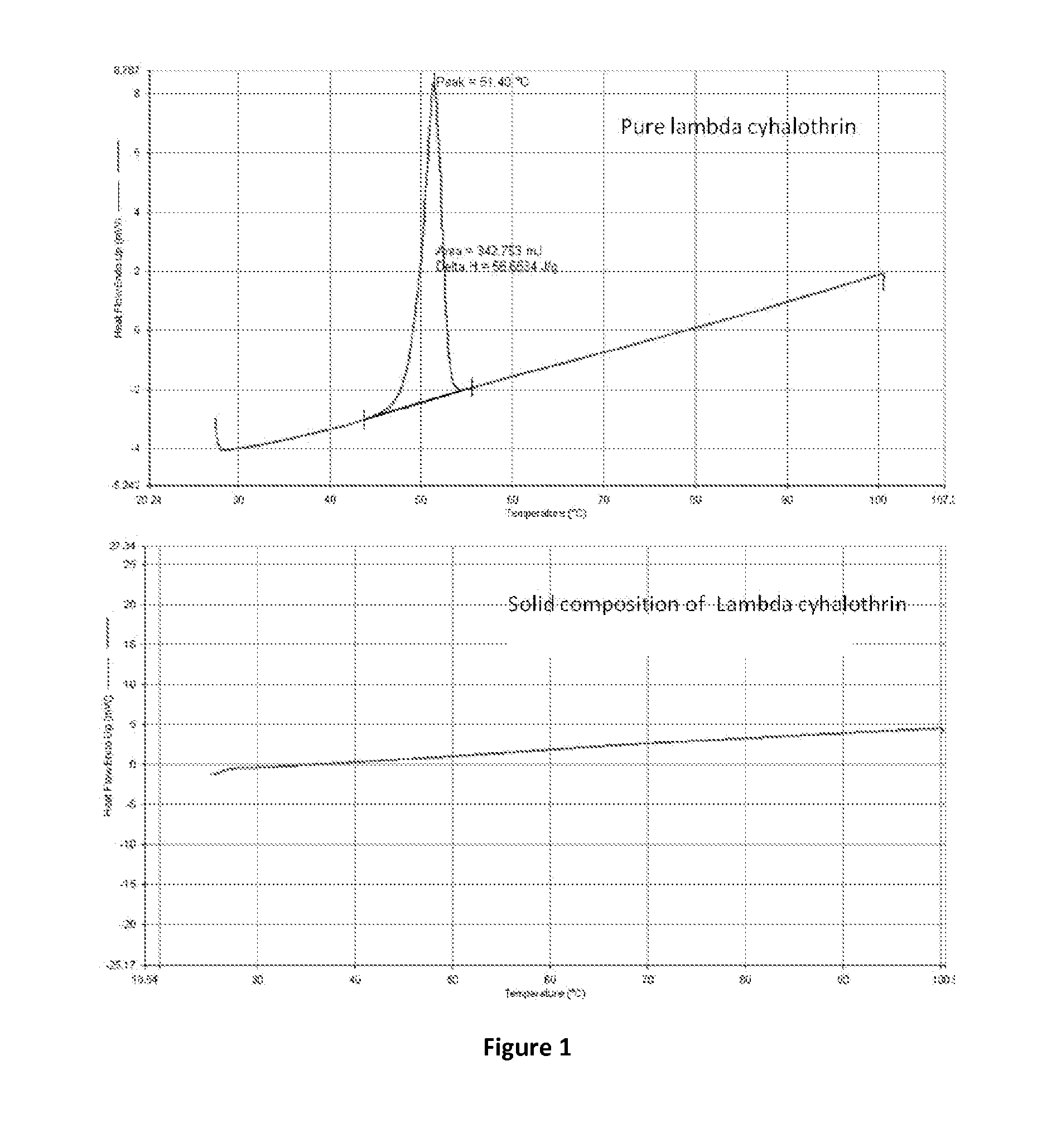Pyrethroid formulations
a technology of pyrethroid and formulation, which is applied in the field of pyrethroid formulation, can solve the problems of low soil mobility, pyrethroids are easily adsorbed to the sediments of natural water systems, and disrupt the function of neurons, and achieve the effect of increasing the pest resistance of plants
- Summary
- Abstract
- Description
- Claims
- Application Information
AI Technical Summary
Benefits of technology
Problems solved by technology
Method used
Image
Examples
example 1
Preparation of 1 g of Polymer Nanoparticles from Poly (Methacrylic Acid-Co-Ethyl Acrylate) (p(MAA-co-EA))
[0472]1 g of polymer nanoparticles derived from p(MAA-co-EA) was made as follows. Briefly, 1 g solid p(MAA-co-EA) (MAA:EA=90:10 or 80:20, MW 450K-800K) was dissolved in 500 mL of deionized water in a 3 L beaker using an overhead stirrer, and pH was maintained at ˜7 with 1M NaOH. The solution was stirred overnight to fully dissolve the solid. The next day, 500 mL of 3M NaCl was added to the solution under vigorous stirring. After addition, the solution was left to stir at 500 rpm for another hour. At this stage, the solution viscosity drops indicating the formation of collapsed polymers. The solution was then transferred to a 3 L recrystallization dish equipped with a magnetic stir bar. This solution was exposed to 4-254 nm UV germicidal lamps (G25T8) for 2 hours under constant stirring. After 2 hours, the solution was removed from the UV source and the ions were removed using dia...
example 2
Formation of a Solid Formulation of Nanoparticles or Aggregates of Nanoparticles of Polymer-Associated Lambda Cyhalothrin Via Spray Drying Directly from Common Solvent
[0475]5 g of polymer nanoparticles derived from p(MAA-co-EA) were made according the procedure outlined in Example 1. The 5 g of polymer powder was dispersed in 250 mL technical grade methanol in a 500 mL glass beaker until a clear solution was formed, and was then filtered through coarse filter paper to remove any undispersed solids. 5 g of technical grade lambda cyhalothrin (Pacific Agrosciences) was added to the filtered dispersion. The resulting solution was clear, and was stirred at 500 rpm using a magnetic stir bar on a stirrer hot plate for one hour. This solution was then spray dried on a Buchi mini Spray dryer B290 with inlet temperature set at 170° C., aspirator gas flow rate of approximately 35 m3 / h, feed rate of approximately 7 mL / min and air flow 601 L / hr. The solid was collected from the collector recepta...
example 3
Formation of a Solid Formulation of Nanoparticles or Aggregates of Nanoparticles of Polymer-Associated Cypermethrin Via Spray Drying Directly from Common Solvent
[0476]5 g of polymer nanoparticles derived from p(MAA-co-EA) were made according the procedure outlined in Example 1. The 5 g of polymer powder was dispersed in 250 mL technical grade methanol in a 500 mL glass beaker until a clear solution was formed, and was then filtered through coarse filter paper to remove any undispersed solids. 5 g of technical grade cypermethrin (Pacific Agrosciences) was added to the filtered dispersion. The resulting solution was clear, and was stirred at 500 rpm using a magnetic stir bar on a stirrer hot plate for one hour. This solution was then spray dried on a Buchi mini Spray dryer B290 with inlet temperature set at 170° C., aspirator gas flow rate of approximately 35 m3 / h, feed rate of approximately 7 mL / min and air flow 601 L / hr. The solid was collected from the collector receptacle of the s...
PUM
| Property | Measurement | Unit |
|---|---|---|
| diameter | aaaaa | aaaaa |
| diameter | aaaaa | aaaaa |
| diameter | aaaaa | aaaaa |
Abstract
Description
Claims
Application Information
 Login to View More
Login to View More - R&D
- Intellectual Property
- Life Sciences
- Materials
- Tech Scout
- Unparalleled Data Quality
- Higher Quality Content
- 60% Fewer Hallucinations
Browse by: Latest US Patents, China's latest patents, Technical Efficacy Thesaurus, Application Domain, Technology Topic, Popular Technical Reports.
© 2025 PatSnap. All rights reserved.Legal|Privacy policy|Modern Slavery Act Transparency Statement|Sitemap|About US| Contact US: help@patsnap.com


